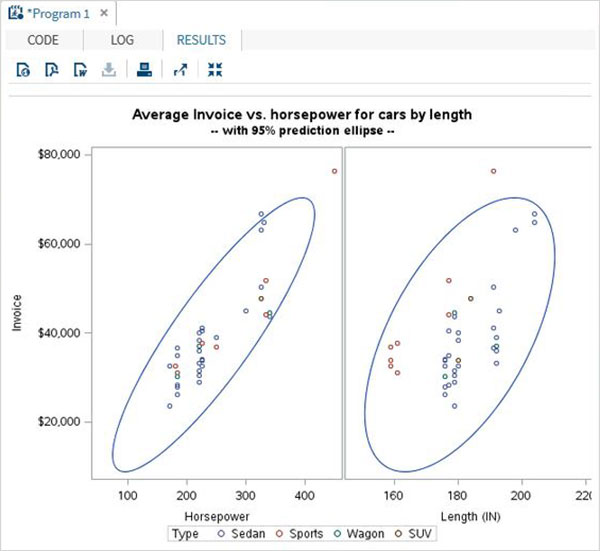请注意,我们在第一个示例中创建名为CARS1的数据集,并对所有后续数据集使用相同的数据集。 此数据集保留在工作库中,直到SAS会话结束。
语法
在SAS中创建散点图的基本语法是:
PROC sgscatter DATA=DATASET; PLOT VARIABLE_1 * VARIABLE_2 / datalabel = VARIABLE group = VARIABLE; RUN;
以下是使用的参数的描述:
- DATASET是数据集的名称。
- VARIABLE是从数据集使用的变量。
简单散点图
在一个简单的散点图中,我们从数据集中选择两个变量,并根据第三个变量对它们进行分组。 我们还可以标记数据。 结果显示两个变量如何分散在笛卡尔平面中。
例
PROC sql; create table CARS1 as SELECT make,model,type,invoice,horsepower,length,weight FROM SASHELP.CARS WHERE make in ('Audi','BMW') ; RUN; TITLE 'Scatterplot - Two Variables'; PROC sgscatter DATA=CARS1; PLOT horsepower*Invoice / datalabel = make group = type grid; title 'Horsepower vs. Invoice for car makers by types'; RUN;
当我们执行上面的代码,我们得到以下的输出:
散点图与预测
我们可以使用估计参数通过围绕值绘制椭圆来预测相关性的强度。 我们使用过程中的附加选项来绘制椭圆,如下所示。
例
proc sgscatter data =cars1;
compare y = Invoice x =(horsepower length)
/ group=type ellipse =(alpha =0.05 type=predicted);
title
'Average Invoice vs. horsepower for cars by length';
title2
'-- with 95% prediction ellipse --'
;
format
Invoice dollar6.0;
run;
当我们执行上面的代码,我们得到以下的输出:

散点矩阵
我们还可以有一个散点图,通过将它们分组成对,涉及多于两个变量。 在下面的示例中,我们考虑三个变量并绘制散点图矩阵。 我们得到3对结果矩阵。
例
PROC sgscatter DATA=CARS1; matrix horsepower invoice length / group = type; title 'Horsepower vs. Invoice vs. Length for car makers by types'; RUN;